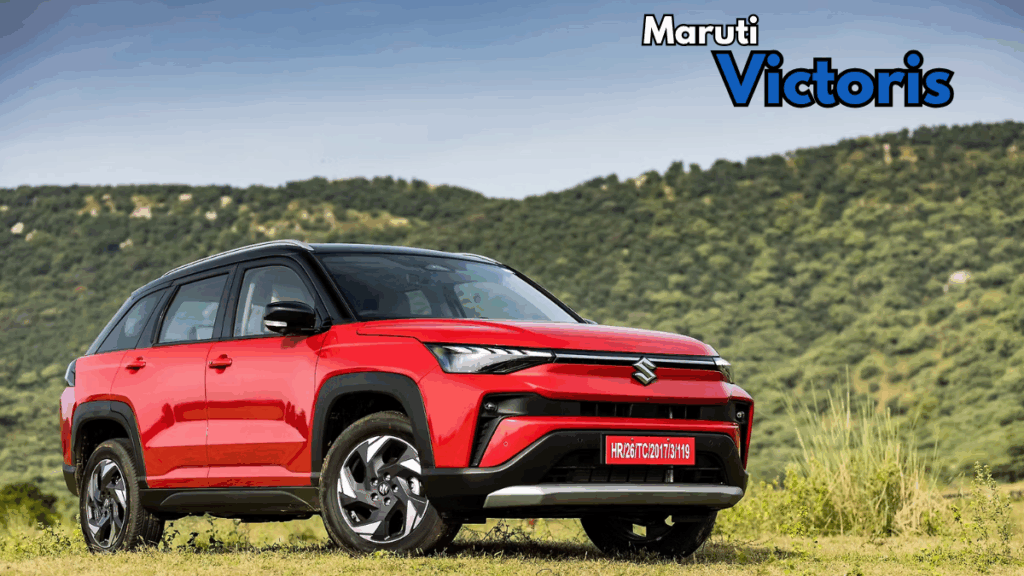Maruti Suzuki’s Victoris has only just begun reaching customers, yet the aftermarket scene is already warming up. A recent example doing the rounds on social media shows a Victoris fitted with massive 22-inch alloy wheels. The owner claims it is among the first such modified units in India, and the video highlights the SUV’s altered stance, the low-profile rubber, and chrome-finished brake calipers that match the bright wheels.
The Victoris in stock form ships with 17-inch wheels across most variants. Jumping five sizes up to 22 inches is a dramatic change. It transforms the character of the car at first glance, but it can also bring mechanical, functional, and legal implications that prospective modifiers should understand before taking the plunge. Below, we break down what changes, what improves, and what may get worse when you go this large.
What 22-Inch Wheels Do Visually
Visually, there is no debate: larger wheels fill the arches better, making the SUV look more upmarket and aggressive. On the showcased build:
- Five-spoke 22-inch design: The open-spoke look exposes the calipers and discs, reinforcing a performance theme.
- Low-profile tyres: Thinner sidewalls reduce the visual bulk of rubber, elevating the alloy design as the focal point.
- Chrome-tinted calipers: A stylistic choice to complement the bright silver alloys.
- Perceived ground clearance: Because the eye reads the larger diameter and wheel-arch gap differently, the SUV can look taller even if the true underbody clearance does not meaningfully increase, depending on tyre sizing.
Quick Summary
Item |
Details |
|---|---|
Vehicle |
Maruti Suzuki Victoris (mid-size SUV) |
Stock Wheel Size |
17-inch alloys (factory) |
Modification |
22-inch, five-spoke silver alloys with low-profile tyres; chrome-finished brake calipers |
Visual Impact |
More presence, sportier stance, seemingly higher ground clearance |
Likely Trade-offs |
Harsher ride, altered steering feel, potential speedometer error, possible mileage drop, higher risk of rim/tyre damage |
Price Range (Ex-showroom) |
Rs 10.50 lakh to Rs 19.99 lakh (variant dependent) |
Demand Snapshot |
Strong early bookings leading to longer waiting periods in some cities |
Official Site |
The Engineering Trade-Offs You Should Know
1) Ride Quality and Comfort
Moving from 17-inch to 22-inch wheels typically reduces sidewall height if you try to keep the overall tyre diameter close to stock. Lower sidewalls flex less, so bumps and potholes are transmitted more sharply into the cabin. Expect a firmer, sometimes harsh ride, particularly over broken tarmac and speed humps.
2) Handling, Steering Feel, and Braking
- Unsprung mass: Larger wheels and tyres usually weigh more, increasing unsprung mass. This can blunt suspension response and reduce composure on rough roads.
- Steering: Wider section tyres can increase tramlining and steering effort, and may alter the steering’s on-center feel.
- Braking: With more rotational inertia, very large wheels can slightly extend stopping distances. Brake performance also depends on tyre compound and contact patch; grip may improve in dry conditions with wider rubber but can worsen in wet if the tyre design is not optimal.
3) Acceleration and Mileage
Heavier, larger-diameter wheel-tyre packages can slow off-the-line responses and trim fuel efficiency. The engine and transmission work harder to spin the mass, especially in city stop-go traffic.
4) Speedometer/Odometer Error
If the new tyre’s overall rolling diameter is different from stock, the speedometer and odometer will misread. A larger overall diameter causes the speedo to under-read (you go faster than indicated), while a smaller one leads to over-reading. Proper tyre size selection is critical.
5) Suspension and Steering Component Wear
Bigger, heavier wheels act like longer levers on the bearings, tie-rods, ball joints, struts, and bushings. Over time, this can accelerate wear, especially on rough roads.
6) Tyre and Wheel Damage Risk
Low-profile tyres have less sidewall cushion, increasing the risk of bent rims, sidewall bulges, and blowouts when hitting potholes, sharp edges, or deep ruts common scenarios on Indian roads.
Legality, Warranty, and Insurance: Read The Fine Print
- Type approval and registration: Any change that materially alters specifications may need to comply with local regulations. Check with your Regional Transport Office and your insurer for acceptability of upsized wheels and tyre profiles.
- Warranty considerations: Dealerships can refuse warranty coverage on parts deemed to be affected by aftermarket modifications. Even if the entire vehicle warranty is not void, claims related to suspension, steering, or wheel bearings could be contested.
- Insurance disclosure: Notifying your insurer about the modification is advisable. Undisclosed changes can complicate claims.
How To Up-Size More Sensibly (If You Must)
If you love the look of bigger wheels but want to keep the downsides in check:
- Match overall diameter: Use a tyre calculator to keep overall rolling diameter within about ±2 percent of stock to minimize speedo error and drivetrain stress.
- Consider intermediate sizes: 18- or 19-inch wheels usually strike a better balance for Indian conditions than 22-inch fits.
- Choose quality tyres: Prioritize tyres with strong sidewall construction and wet-grip performance.
- Go lightweight: Forged or flow-formed wheels help reduce unsprung mass compared to cast designs.
- Get alignment and balancing: After any wheel change, do a full alignment, balancing, and a short re-torque check after 100–200 km.
- Mind offset and width: Incorrect offset can cause rubbing on full lock or over bumps, or even stress suspension geometry.
Victoris Snapshot: Variants, Prices, Demand
The Victoris line-up spans petrol, strong-hybrid, and S-CNG options, with manual, automatic, and hybrid e-CVT transmissions. Factory wheel size is 17 inches on most variants. Ex-showroom prices presently run from about Rs 10.50 lakh to Rs 19.99 lakh, depending on trim and powertrain. Early demand has been robust, with strong bookings reported across major cities—resulting in noticeable waiting periods for certain configurations.
Should You Go 22 Inches? Verdict
- Yay if your priority is pure aesthetics, show presence, and you mostly drive on smooth urban roads. Be ready to accept firmer ride quality, slightly dulled responses, and the costs of premium low-profile tyres.
- Nay if you frequently travel on broken roads, value comfort, want to preserve factory dynamics and component life, or are concerned about warranty and insurance nuances.
For many owners, a well-chosen 18- or 19-inch setup with quality tyres offers a satisfying visual upgrade with substantially fewer compromises than a leap to 22 inches.
Official Site
Explore the Victoris range, variants, and features on Maruti Suzuki Arena:
https://www.marutisuzuki.com/arena/victoris
Frequently Asked Questions (FAQs)
1) Will 22-inch wheels void my warranty?
Not automatically, but warranty claims tied to affected parts—suspension, steering, wheel bearings, or tyres—can be questioned. Always confirm with your dealership before modifying.
2) How much will mileage drop with 22-inch wheels?
Expect some reduction due to added mass and rolling resistance. Real-world impact varies with tyre choice, pressure, driving style, and traffic conditions.
3) Can I keep the speedometer accurate after upsizing?
Yes, by choosing tyre sizes that keep overall rolling diameter close to stock (ideally within ±2 percent). A tyre professional can calculate suitable sizes.
4) Are low-profile tyres safe for Indian roads?
They are safe when inflated correctly and driven with care, but they are less forgiving over potholes and sharp edges, and rims are easier to damage.
5) Will handling improve with 22-inch wheels?
Turn-in may feel sharper due to stiffer sidewalls, but added unsprung mass can reduce overall composure on rough surfaces. It is a trade-off.
6) Do I need to declare the modification to my insurer?
Yes. Disclosing major modifications helps avoid disputes during claims processing.
7) What is a more balanced upgrade if I still want larger wheels?
Consider 18- or 19-inch lightweight alloys with high-quality tyres designed for Indian conditions. This often preserves comfort while improving stance.
Conclusion
The 22-inch conversion gives the Maruti Suzuki Victoris standout curb appeal and an unmistakably premium look. However, it comes at the cost of comfort, potential component wear, and possible warranty or insurance complications. If your usage leans toward smooth city commutes and you value the show-car aesthetic, this is a bold, head-turning mod. If your priorities are daily drivability, long-term reliability, and balanced dynamics, a more modest upsize paired with strong tyres will deliver a better everyday experience without diluting the essence that makes the Victoris an appealing new entrant in the mid-size SUV space.
For More Information Click Here





